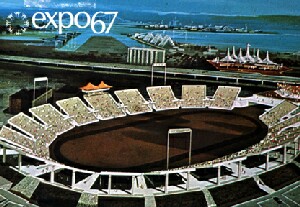|
1 |
 Copyright: |
|
1 |
 Copyright: |
Sibyl Moholy-Nagy: Expo '67
Seen in practical terms, this presentation is a cacophony of architectural FUN HATS - funny hats, in steel, concrete, stone, wood, Plexiglas and plastic, symbolically underscored by innumerable sales booths which offer grotesque headwear of unparalleled ridiculousness. The last wisdom of Dewey's philosophy of education, that learning should be a game, has found its sublimated refutation here. There is namely not the slightest relationship between the form and the exhibition material of the pavilions, apart from a few exceptions. (...)
Amongst the technical experiments and realized concepts, Fuller's colossal soap-bubble is by far the most out-dated. No-one can deny that the geodesic dome can encompass the largest cubic contents with the least material, but we also know that it is not only the costliest, but also the most inflexible structural system. As Gertrude Stein so rightly commented: a tetrahedron is a tetrahedron is a tetrahedron - and there is only a single solution to combining them into a sphere, a solution that was known way back to Leonardo da Vinci. The deluge of propaganda has only one feature in common with the ostentatious American palace - size! It is the largest geodesic dome (20 stories high, 76 meters in diameter), the most expensive dome (9.3 million dollars) and - what more could you want? - the emptiest geodesic dome."
Source: Bauwelt, Vol. 58, 1967, No. 28/29, pages 687-696, here pages 688 and 692.
O.A: Habitat
Expo's experimental housing project, known as Habitat and designed by Moshe Safdie, can be praised for a number of things: as a visually stimulating exhibition item; as a means of opening the visitor's eyes to possibilities in the way of planning, designing and constructing dwelling houses and showing him how many alternatives there are to what he is used to; as a means of testing the validity of new fabrication techniques. The fact that tested on this scale (158 dwellings) Habitat is meaningless economically - that the cost of each house as built puts them in the luxury class - does not matter in this context. The purpose of an exhibition is to make experiments that would not be economically justified in other contexts. Regarded thus as a pilot exercise, the Habitat houses have already demonstrated some of the things that will need restudying if the experiment is going to make a real contribution to housing technique - apart from the need to rationalize the economic basis. (...) From the point of view of planning the chief fault that has shown itself is the lack of privacy - too many of the roof terraces and even living and bedroom windows are overlocked at close range. From the technical point of view - although a full analysis has still to be made - the chief defects seem to be that the full degree of prefabrication originally intended, with all services incorporated and decorations completed before the concrete boxes were hoisted into place, has not proved practicable in practice and that the rate of fixing the precast box-units slower than the rate of casting them, making an economic flow of work difficult; also the ways in which the boxes can be arranged to make dwellings of different plan-form and sizes, seems to have led to almost every one being designed differently, thus diminishing the advantage of standardizing components.
Source: Architectural Review, Vol. 142,
August 1967, pages 143-146, here page 143.
| Year: 1967 | City: Montreal | Country: Canada |
| Duration: 28th April - 27th October 1967 | ||